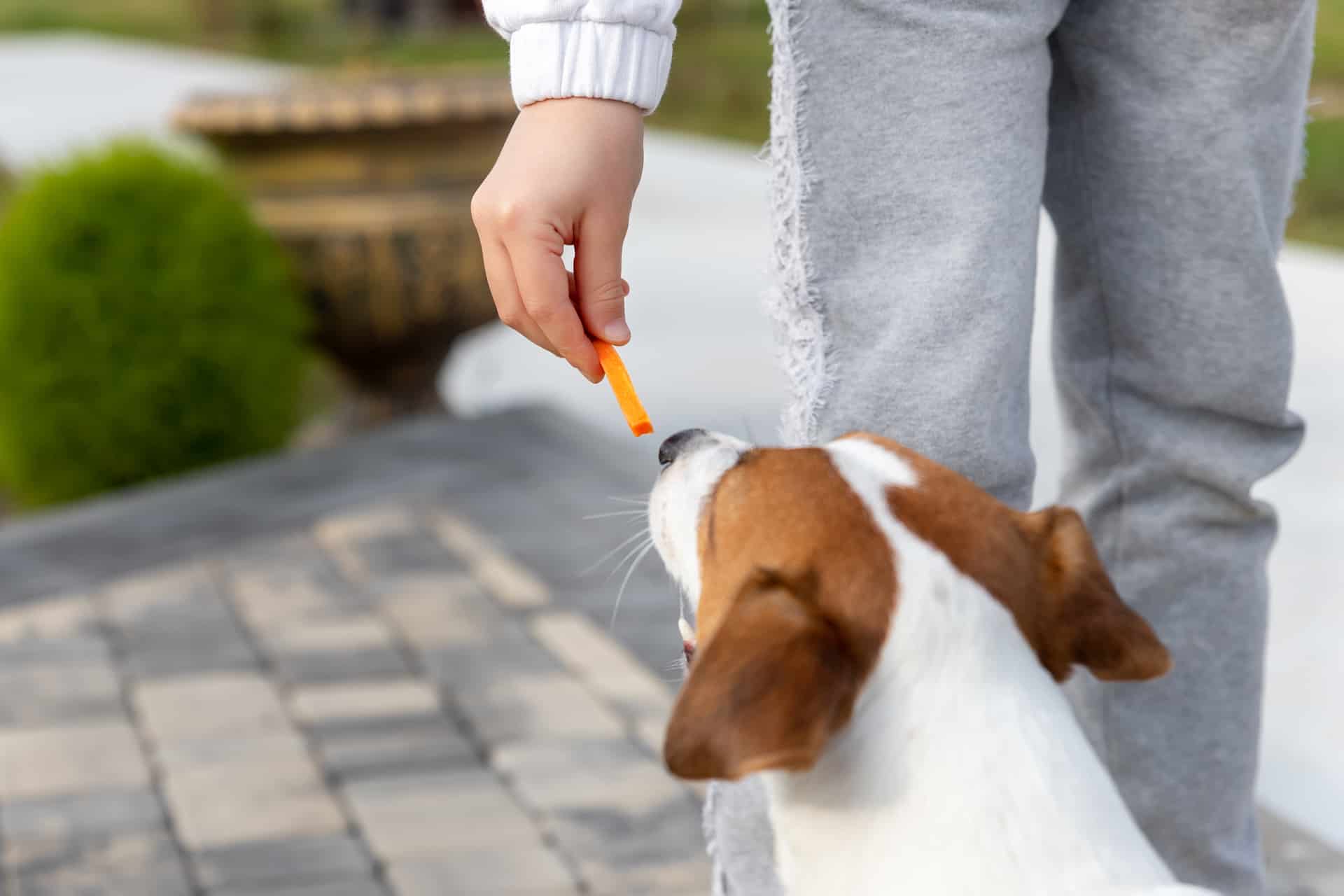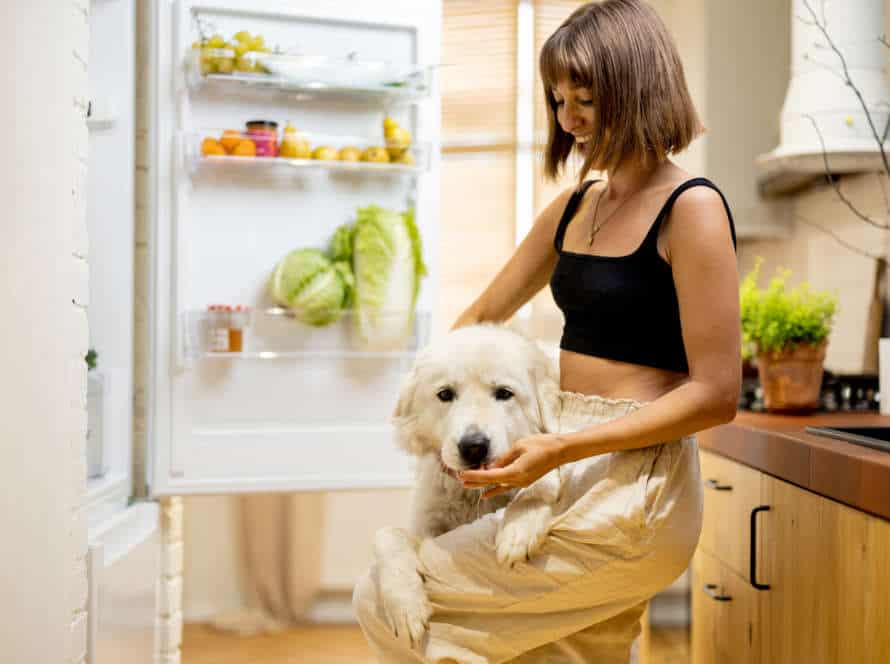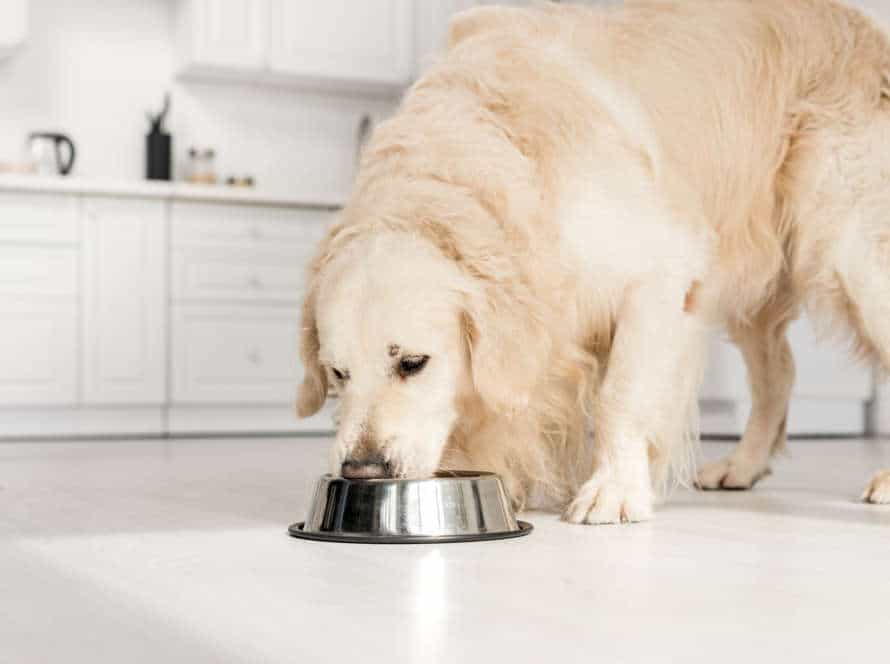Adult Dog Nutrition: Tips for a Healthy, Balanced Diet
It’s essential to feed your adult dog a nutritious and balanced diet for their wellbeing and life span. Here’s how:
- Choose a high quality dog food that suits your pup’s nutritional needs, based on their age, size, breed, and activity level.
- Don’t give them too much food, follow the recommended serving size to prevent obesity and health problems.
- Give them a variety of protein sources, like meat, fish, and plant-based proteins, to ensure they get all the essential amino acids.
- Include healthy fats and oils, such as fish oil or flaxseed oil, to support their immune system, skin and coat health.
- Offer fresh fruits and veggies as a source of vitamins, minerals, and fiber, but beware of toxic foods like grapes, onions, and chocolate.
Pro tip: Talk to your vet to create a personalized diet plan for your adult dog based on their needs and health conditions.
Understanding your Dog’s Nutritional Needs
It’s essential to understand your pup’s dietary needs. You must know the correct type and amount of food they should eat for a balanced diet. Here we will look at the nutrients vital for your doggo, how to measure the calories they need, and the top way to keep them properly nourished.
Factors to Consider When Choosing Dog Food
Making the right choice for your pup’s food can be confusing. Here are some things you can consider when choosing:
- Dog’s age, breed, and size: They each have special nutritional needs to stay healthy and grow.
- Quality of ingredients: Look for real meats, veggies, and grains, and make sure it’s easily digestible.
- Nutritional requirements: Ask a vet what your pup needs based on health, activity level, and weight.
- Type of diet: Some dogs may need grain-free, raw food, or low-fat diets. Ask a vet what’s right.
- Type of food: Dry, wet, and semi-moist all have pros and cons for taste, cost, and more.
It’s important to consider all these factors to give your pup a balanced diet.
How to Read Dog Food Labels
Reading labels on dog food can be tough. But it’s crucial to know what nutrition your furry mate needs for a healthy, happy life. So, here’s how to crack it:
- Look at the ingredients list. Opt for whole meats like beef or chicken, not fillers like wheat, soy, or corn.
- Check the Guaranteed Analysis for protein, fat, and fiber percentage. Make sure it suits your pup.
- Check the calorie content. See if it fits their age, activity level, and breed.
- Check for the Nutritional Adequacy Statement. It should state if the food meets the requirements of their life stage, e.g. puppy, adult, or senior.
Knowing the value of reading dog food labels helps you make the best choice for your pup. Pro tip: Ask your vet for a diet plan tailored to your pup’s individual nutritional needs.
Understanding Nutrition Requirements for Adult Dogs
It’s important to understand the nutrition needs of adult dogs. A balanced and healthy diet is key for their growth, development, and overall well-being. They need protein, carbs, fats, vitamins, and minerals in the right proportions. This helps with maintaining their weight, building muscles, supporting organ function, boosting immunity, and promoting healthy skin and teeth. Here’s how:
- Choose a high-quality dog food with the right balance of protein, carbs, and fat.
- Feed them the recommended serving size for their weight, activity level, and breed.
- Provide fresh, clean water always.
- Don’t give them foods that are toxic to dogs, like chocolate, onions, or grapes.
- If you’re not sure, check with your vet.
Pro tip: To make their diet interesting, add small amounts of lean meat, fruits, and vegetables. But avoid foods that are high in sodium, fat, and sugar.
The Importance of a Balanced Diet for Adult Dogs
Adult dogs need a balanced diet to stay healthy. This diet must contain proteins, carbs, fats, vitamins and minerals. Plus, it keeps energy levels high, avoids illness and makes fur and skin glow!
Let’s explore the importance of a balanced diet for adult dogs and some tips on how to achieve it.
Components of a Balanced Diet
A balanced diet is essential for a pup’s health and wellness. It gives them all the nutrients they need in the right amounts to keep their body functioning properly, support their immune system, and maintain a healthy weight.
Protein should make up at least 18% of their diet and should be meat-based. Carbs give energy and fiber for digestion, but should be kept to 30-50%. Fats are vital for a healthy coat, but mustn’t be excessive – this can lead to being overweight. Vitamins and minerals are necessary too, and a variety of fruits and veg can provide these. Also, ensure your pup always has clean water with plenty of hydration.
Lastly, check with your vet to see what diet is best for your pooch’s needs.
Benefits of a Balanced Diet
Feeding your adult pup a balanced diet is key for their health and wellbeing. Here are some advantages:
- Healthy weight: The right amount of nutrients helps keep their weight ideal, warding off obesity and any related health problems.
- Boosts immunity: Vitamins, minerals and antioxidants increase the immune system, and reduce their danger of illnesses and diseases.
- Shiny coat: Amino acids and fatty acids in the diet keep their skin and coat shiny and lustrous.
- Brain function: Omega-3 and omega-6 fatty acids nurture the brain, increasing their behavior and cognitive function.
- Regulates digestion: A balanced diet helps with digestion and improves gut health.
Pro tip: Get advice from your vet on the best nutrition for your pup, taking into account their breed, age and health status.
The Risks of Feeding Your Dog an Unbalanced Diet
Feeding a dog an unbalanced diet has serious health impacts. It’s vital to comprehend the significance of a healthy and balanced diet for your furry friend’s well-being.
An unbalanced diet may cause deficiencies of essential nutrients like vitamins, minerals, and protein. This can lead to expensive veterinary treatments in the long run. Plus, overfeeding certain foods can cause obesity or even toxicity.
A healthy and balanced diet for adult dogs should include high-quality protein, healthy fats, veggies, and fruits to supply essential nutrients. Speak with a vet or a certified animal nutritionist to create a personalized feeding plan for your pup.
Pro tip: Give your pup fresh water and avoid giving them table scraps or human food. This can disrupt their digestive system and cause health issues.
Choosing the Right Type of Food for Your Adult Dog
When considering nutrition for your adult dog, the type of food is key. Selecting the right food will ensure a balanced diet, which is essential for health. There are various types of food; kibbles, canned and raw. Here, we will look at the advantages and disadvantages of each type. Afterwards, you can decide which option is best for your dog.
Dry Food vs. Wet Food
Choosing food for an adult dog is an important choice. Dry and wet food both have pros and cons. As a dog owner, it’s key to pick the right one for your pet.
Dry Food: Cheaper, easier to store, and has a longer shelf life. Helps with oral health too. But, it is low in moisture and dogs may not drink enough water.
Wet Food: High in protein, moisture, and fats. Great for dogs with dental issues, medical conditions, or a picky appetite. But, it’s pricier than dry food, has a shorter shelf life, and can cause dental issues if fed only.
A mix of both is the best way for a balanced diet. Ensuring your pup has access to clean water is essential for their health too.
Choosing the Right Protein Source
Selecting the correct protein source for your adult dog is essential to give them the right amount of nutrients they need to stay fit and active. Here are some helpful tips:
- Estimate their individual dietary needs based on age, size, and activity level.
- Look for high-quality proteins like chicken, beef, lamb, or fish.
- Think about your dog’s dietary limits or sensitivities when deciding on a protein source.
- Evade fillers or by-products that are of low nutritional value or may cause digestive issues.
- Consult with your vet or veterinary nutritionist to pick the finest protein source and type of food for your dog’s particular needs.
Avoiding Common Allergens and Food Sensitivities
When picking food for your adult dog, consider common allergens and food sensitivities. Here are some tips:
- Spot potential allergens: Beef, chicken, dairy, and wheat might be bad. Avoid them if your pup has had allergies before.
- Choose high-quality proteins: Look for whole protein sources like chicken, fish, and lamb as the first ingredient. These give your dog all the amino acids they need.
- Avoid fillers and artificial preservatives: Many dog foods contain fillers like corn or soy with little nutrition. Pick food without artificial flavors, colors, and preservatives.
- Grain-free options: If your pup is sensitive to grains, try grain-free dog food. It uses sweet potato or peas instead of grains.
By keeping allergens and sensitivities in mind, you can find food that’s nutritious and fits your dog’s diet needs.
How Much to Feed Your Adult Dog
Adult dogs need a healthy, balanced diet. This will give them energy, aid digestion and make their coat shine. Deciding how much to feed your adult dog can be difficult. Look at factors like breed, size and activity level for help. Here’s the lowdown on how much to feed your adult dog:
Calculating Your Dog’s Daily Caloric Needs
Calculating your pooch’s daily caloric needs is necessary to guarantee their wellness and proper weight. There are several important aspects to consider when computing your dog’s daily caloric requirements, like age, weight, type, activity level, and overall health condition.
Here is an easy formula to figure out your pup’s daily caloric requirement:
Multiply your dog’s body weight (in kilograms) by 30. Then, add 70 to the result. The final number is the amount of calories your pup needs per day to stay at the same weight.
For example, if your dog is 10 kg, their daily calorie need would be (10 x 30) + 70 = 370 calories.
It’s important to remember that this is just a rough calculation, so you should consult a vet to know the exact caloric requirements for your pup. Additionally, it’s essential to feed your dog a nutritious, balanced diet that fits their specific nutritional needs. Talk with your vet to develop a custom meal plan for your pup’s wellness.
Portion Control and Feeding Schedules
When it comes to your adult dog’s health, portion control and feeding schedules are key! Here are some tips on how much to feed:
- Start with the package recommendation for your pup’s weight. But don’t forget, every dog is unique. Factors like age, activity level, and health could mean their caloric needs vary.
- Use body condition scoring to make sure you feed the right amount. Your pup’s ribs should be felt, not seen. Plus, you should see a waistline!
- Rather than one big meal, feed your pup twice or three times a day. This keeps the metabolism in check and stops overeating.
- Treats should account for no more than 10% of daily calories.
- If you have questions or concerns about your pup’s diet, or if they have health conditions, talk to your vet.
Adjusting Your Dog’s Diet for Special Needs or Health Issues
If you’re a dog owner, it’s essential to adjust your pup’s diet to fit their health needs. Here’s what you need to know:
- Overweight dogs: Feed them a balanced, low-fat diet. Consider a weight loss formula and lower their calorie intake. Increase exercise, too.
- Senior dogs: Find food with low fat and protein that’s easy to digest. Look for brands for seniors which may have joint-supporting ingredients.
- Dogs with allergies: Identify the allergen and remove it from their diet. Ask a vet to help identify the allergen. Consider a limited-ingredient or allergy-specific food.
- Dogs with health conditions: Design a special diet with a vet.
Always check with a vet before changing your pup’s diet!
Supplementing Your Dog’s Diet with Treats and Table Scraps
Treats and table scraps? A great idea to boost your dog’s diet! They can give all the vital nutrients that your pup needs. Plus, they make a perfect reward for good behaviour. But, you must know when and how to give ’em. Here, let’s explore if adding treats and scraps is a pro or a con.
Guidelines for Choosing Healthy Treats
When selecting healthy treats for your pup, think about their nourishing needs, taste preferences, and potential food sensitivities/allergies. Here are some tips:
- Search for treats with proteins like chicken, beef, or fish. Steer clear of treats with by-products or fillers like corn or wheat.
- Check calory content. Too many treats can lead to obesity or other health issues.
- Match the treat size and texture to your pup’s size and breed.
- Say no to table scraps. This can cause obesity, digestion problems, or nutritional deficiencies.
- Introduce new treats gradually and look out for any allergic reactions or changes in behavior/stool.
- Treats should only supplement your pup’s diet – not replace meals. Consult your vet for customized nutrition advice.
Avoiding Dangerous Foods and Ingredients
Many human foods can be dangerous for dogs. They can cause serious health problems. Therefore, it’s important to not give them to your pooch.
Here are some to avoid:
- Chocolate – It has theobromine which can be toxic and lead to vomiting, diarrhea, and even death.
- Grapes and raisins – They can lead to kidney failure.
- Onions and garlic – They have compounds that can harm red blood cells, causing anemia.
- Avocado – It has persin, a toxin which can cause vomiting, diarrhea and other digestive issues.
Also, it’s okay to give treats and table scraps, but only in moderation and with foods that are safe for dogs.
Pro tip: Research and consult your vet before introducing new foods to your dog’s diet.
Nutritious Alternatives to Traditional Treats and Table Scraps
For your pup’s health and wellbeing, there’re nutritious alternatives to traditional treats and table scraps. Consider these healthy options:
- Carrots – low in calories, high in fiber, and packed with vitamins and minerals.
- Blueberries – full of antioxidants, vitamins, and fiber. Serve them fresh or frozen.
- Green beans – low in calories and high in fiber.
- Lean proteins – like chicken, turkey, and fish, great sources of protein, omega-3 fatty acids, and other essential nutrients.
But, beware! Table scraps and traditional treats are often high in fat, salt, and sugar. So, consult your vet before introducing new foods to your dog’s diet.
Frequently Asked Questions
1. What are the most important nutrients that adult dogs need in their diet?
Adult dogs require a balanced diet that contains protein, carbohydrates, fats, vitamins, and minerals. Protein is particularly important as it helps maintain muscle mass and supports healthy digestion.
2. How much should I feed my adult dog?
The amount of food your adult dog needs depends on their age, breed, weight, and activity level. Your veterinarian can help you determine the appropriate amount of food to feed your dog based on their specific needs.
3. Can I give my adult dog human food?
While some human foods can be safe for dogs to eat, it’s important to be cautious and avoid foods that could be harmful. Certain foods, such as chocolate, grapes, and onions can be toxic to dogs. It’s best to stick to a balanced diet formulated specifically for dogs.
4. How often should I feed my adult dog?
Adult dogs can be fed once or twice a day, depending on their individual needs. Some dogs prefer to graze throughout the day, while others do better with set mealtimes. Your veterinarian can help you determine the feeding schedule that’s best for your dog.
5. Can I give my adult dog supplements?
While some supplements can be beneficial for dogs, it’s important to consult with your veterinarian before giving your dog any supplements. Giving your dog too many supplements can actually be harmful and can also interfere with a balanced diet.
6. How do I know if my adult dog is getting the right nutrition?
Your adult dog should maintain a healthy weight, have a shiny coat, and have plenty of energy if they are getting the right nutrition. If you notice changes in your dog’s weight or energy levels, it’s important to consult with your veterinarian to ensure they are getting the appropriate nutrients they need.







